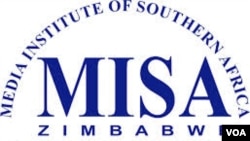The Zimbabwe chapter of the Media Institute of Southern Africa says there was a marked reduction in the number of cases involving media violations in the country with a total of 22 cases in 2014 compared to 28 in the previous year.
In its State of the Media Report published Thursday, MISA attributed the reduction to several issues including less political tension between opposition parties and the ruling Zanu PF party before and after the 2013 general election.
However, MISA director Nhlanhla Ngwenya said Zanu PF continues to be intolerant to criticism as even First Lady Grace Mugabe allegedly threatened journalists at her ‘Meet the People’ rallies before the controversial Zanu PF congress last month.
“As noted in our 2013 report and commendably so, there was marked reduction in the number of cases involving media violations with a total of 22 cases compared to the 28 reported in 2013. This is indeed a positive trend by Zimbabwean standards when viewed against the 80 alerts issued in 2009 pertaining to media violations which then dropped to a total of 27 in 2010, 28 in 2011, with a similar number recorded in 2012.”
MISA noted that while this reduction is commendable, the nature of the violations recorded in 2014 is cause for great concern in that some of the cases involve the assault of journalists on duty by security personnel. “What is even more aggravating are the threats issued against journalists by ruling Zanu PF and senior government officials.”
VIOLATED JOURNALISTS
Some of the cited examples include Anjela Jimu, a photographer with the Zimbabwe Mail, who on 18 August 18th, 2014, sustained a swollen arm after being assaulted by the police while covering a demonstration in Harare by opposition MDC-T youths.
In a similar incident, Privilege Musvanhiri, an online editor with the same paper, on September 19th, 2014, sustained bruises in the back after he was assaulted and arrested by members of the Harare Municipal Police while taking pictures of clashes between council workers and commuter omnibus operators.
The other ones were Justin Mutenda, a photographer with The Herald, who was on October 16th stripped naked by a security officer at Harare International Airport while covering the departure of the national cricket team for Bangladesh and Daily News reporter Tapowa Zivira.
This reporter was assaulted and detained for four hours by police in Harare while recording video footage of a police blitz against touts operating in the central business district.
In Masvingo on 22 October 2014, freelance journalist Wilson Maphosa, was arrested by police while taking pictures of houses that had allegedly been burnt by the police and charged with criminal nuisance in terms of Section 46 of the Criminal Law (Codification and Reform) Act.
MISA said, “These cases are a serious indictment on the police’s wanton acts of impunity and disregard of the constitutionally guaranteed right to media freedom. None of the culprits involved in the assault of the journalists in question had been brought to book at the time of the writing of this report as happens in most cases involving security agents.
“These violations cannot be taken lightly when viewed against threats by Media, Information and Broadcasting Services Secretary George Charamba on October 8, 2014. Charamba was reported on Zimbabwe Television warning the media that the government could resort to administering ‘unpalatable instruments’ to rein in media deemed to be unprofessional.”
FIRST LADY GRACE MUGABE
MISA Zimbabwe further noted that even more ominous was the First Lady Grace Mugabe’s veiled threats against journalists working for the privately owned Newsday and Daily News during her ‘Meet the People’ rallies following her entry into politics.
“While the media is not immune to criticism, the First Lady’s ranting and ravings particularly against journalists working for the Daily News at a Zanu PF rally in Marondera on 17 October 2014, was indeed frightening as experienced and recounted by the affected journalist.
Daily News journalist Fungai Kwaramba was among the posse of journalists at Rudhaka Stadium in
Marondera when Mrs. Mugabe let rip her venom against journalists working for the publication demanding that they identify themselves.
“According to media reports, the atmosphere at Rudhaka was highly charged given the enmity among supporters of the different factions within Zanu PF who could easily have taken the law into their own hands. One can only shudder as to that which could have befallen the journalist if he had stood up and identified himself among the sea of the highly agitated party supporters as demanded by the First Lady,” said MISA in the report.
MEDIA REFORMS-NEW CONSTITUTION
It also noted the lack of media law reforms, saying the Access to Information and Protection of Privacy Act (AIPPA) and others are still intact despite having a new constitution in Zimbabwe that outlaws some provisions of some of these laws.
MISA said, “The continued existence of restrictive laws such as AIPPA, Criminal Defamation, Public Order and Security Act (POSA), Interception of Communications Act and the Entertainment Controls Act, has a serious bearing on citizens’ full enjoyment of the right to freedom of expression and access to information.
“This is despite rulings against criminal defamation made by the Supreme Court in 2013 and 2014 in terms of the old Constitution as well as assertions by the Minister of Media, Information and Broadcasting Services, Professor Jonathan Moyo, that criminal defamation should be repealed.”




